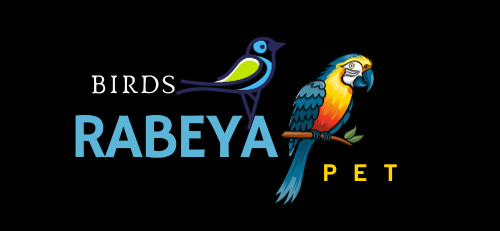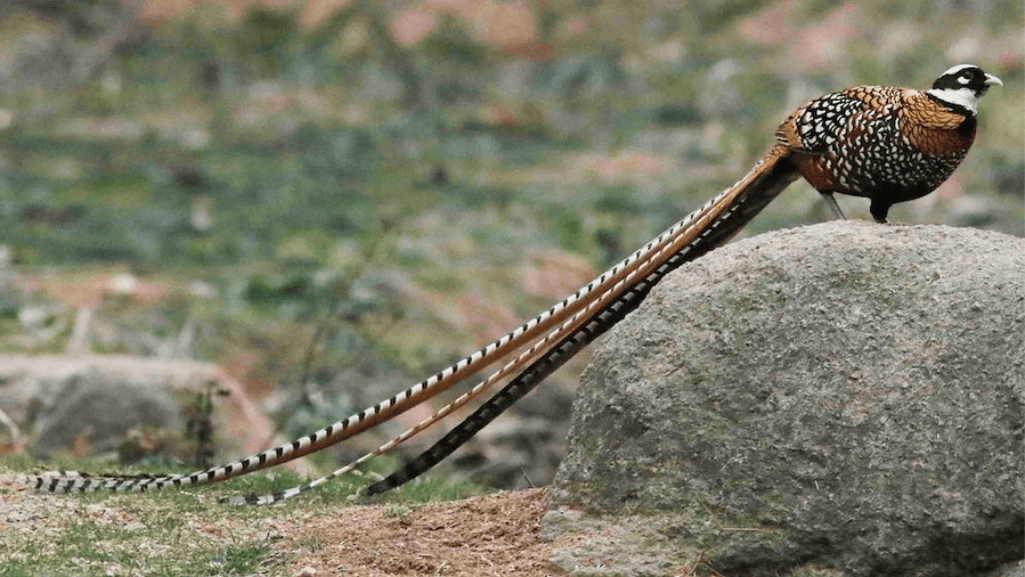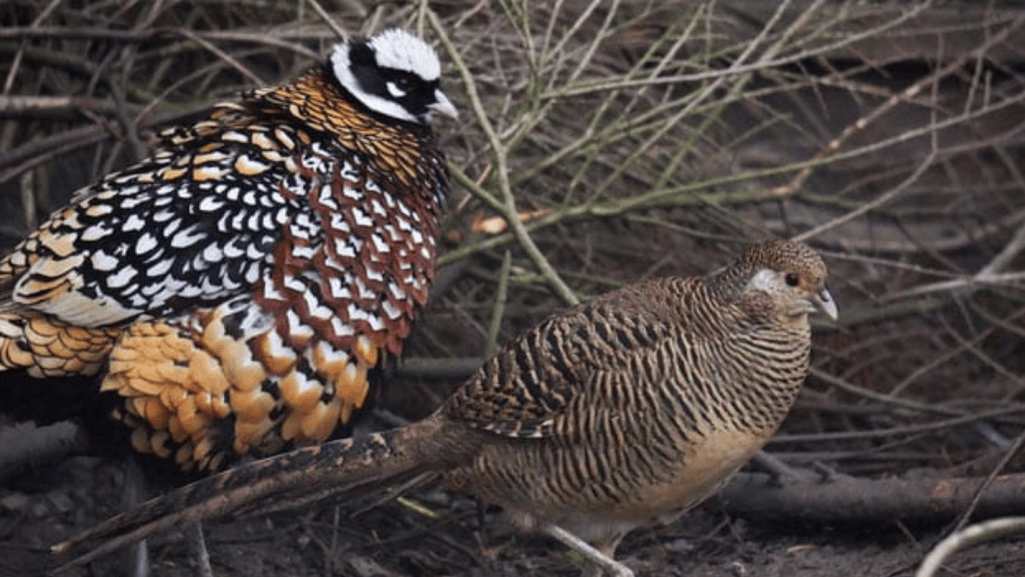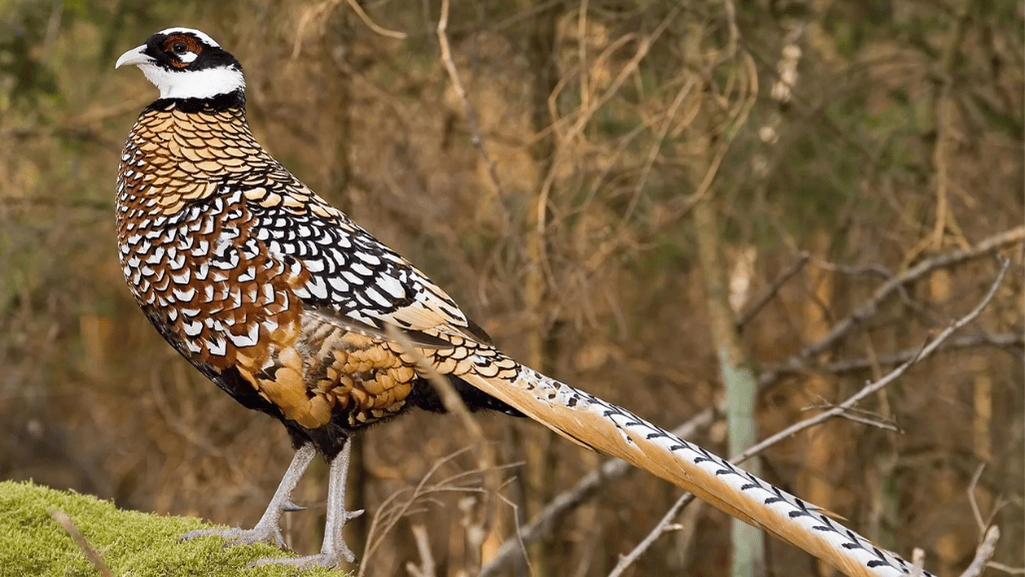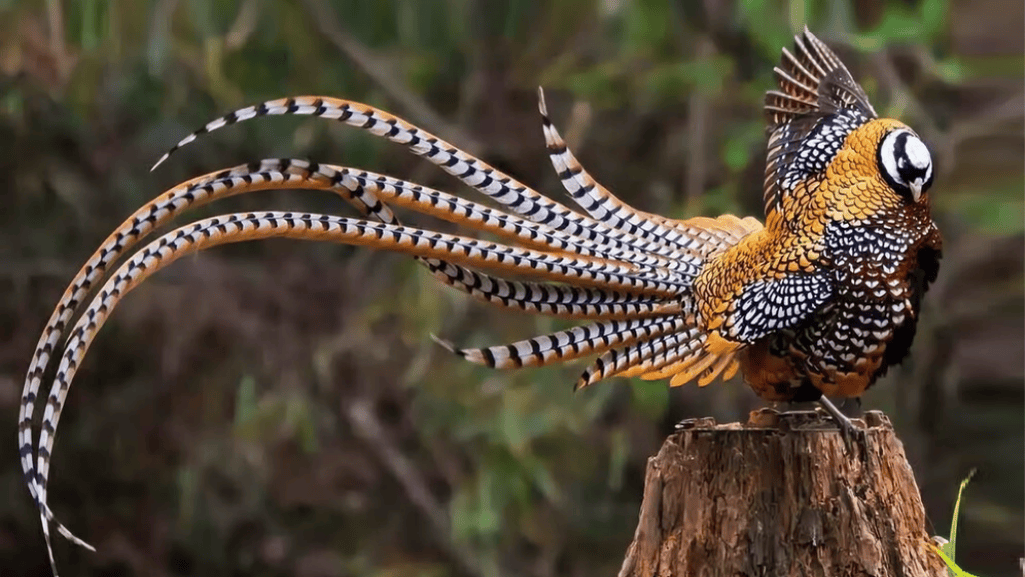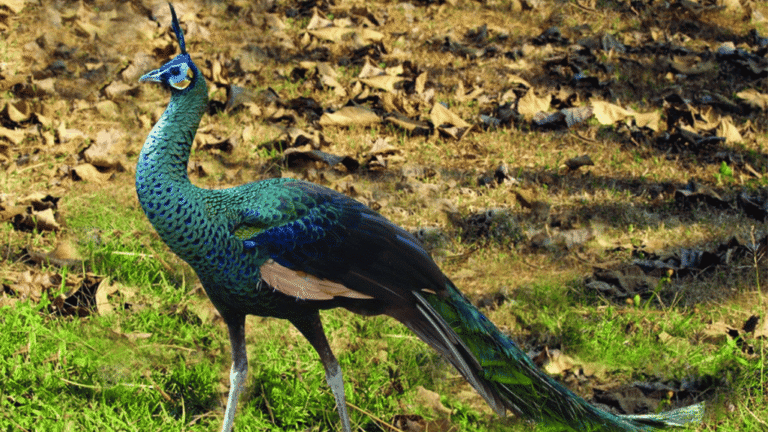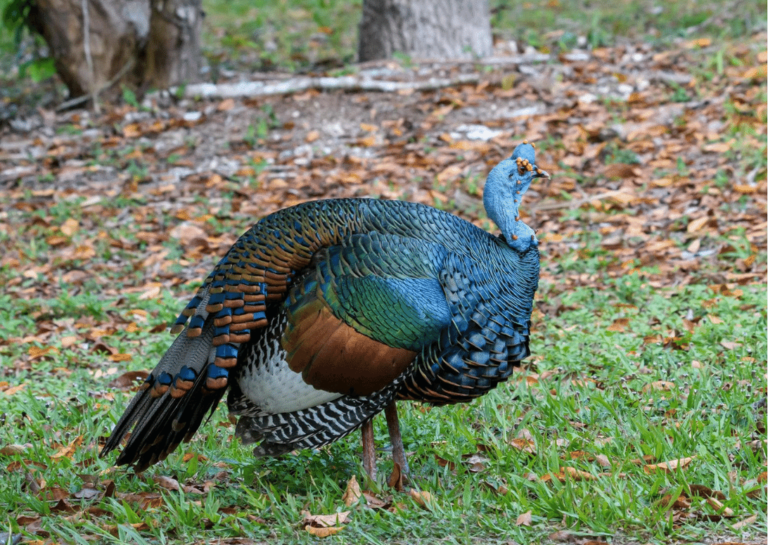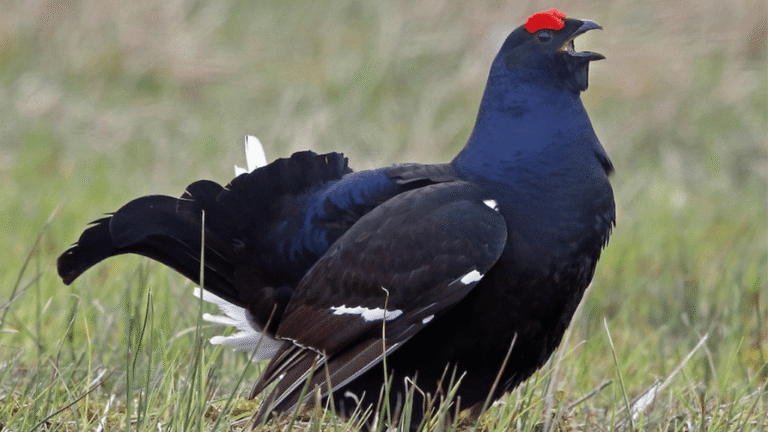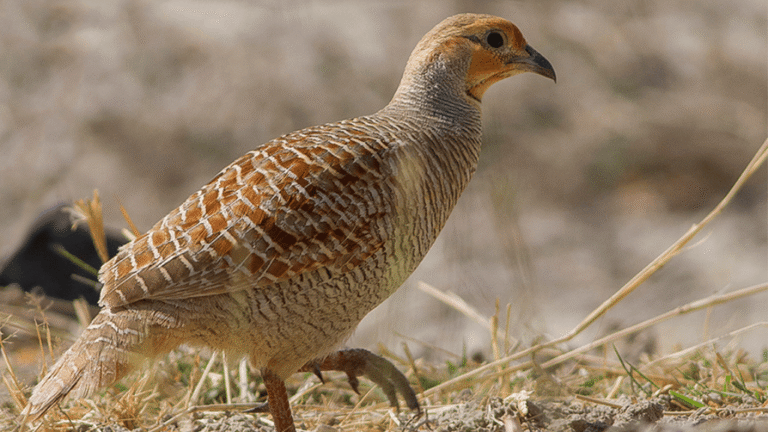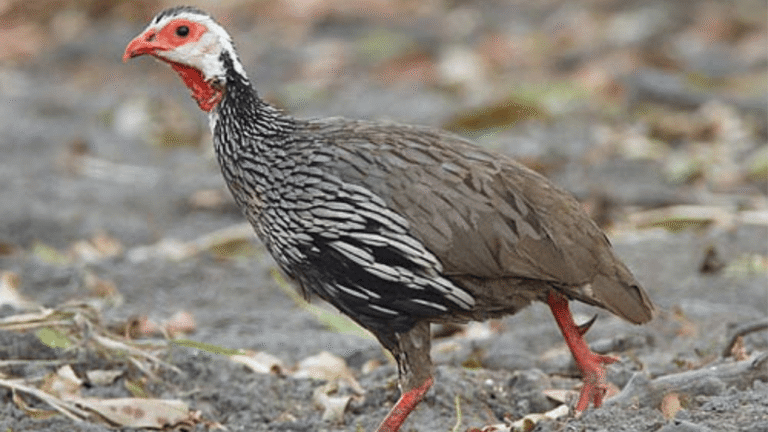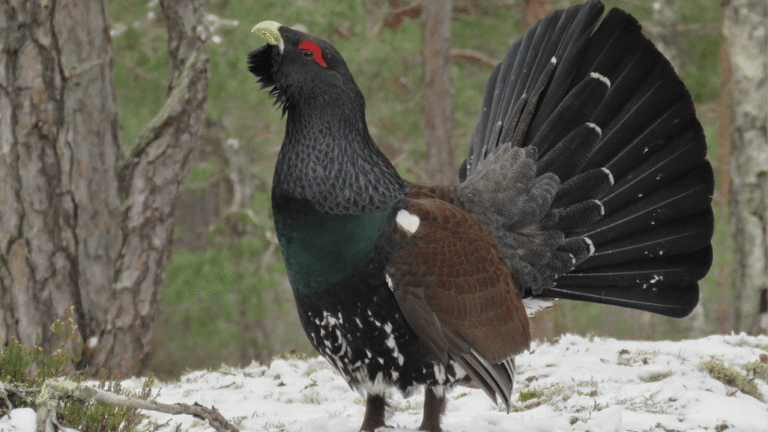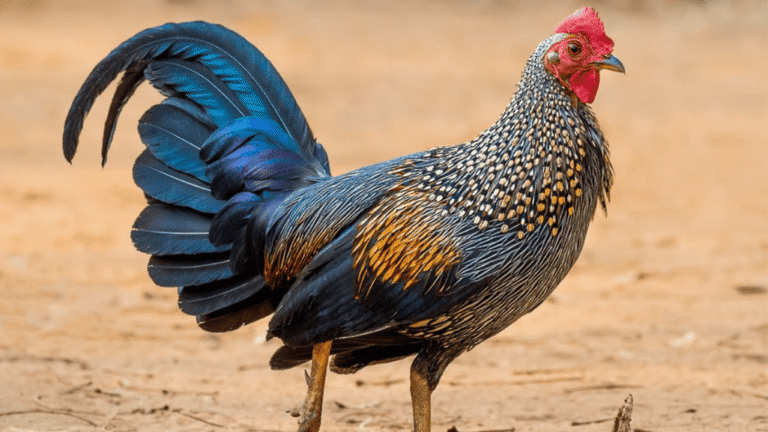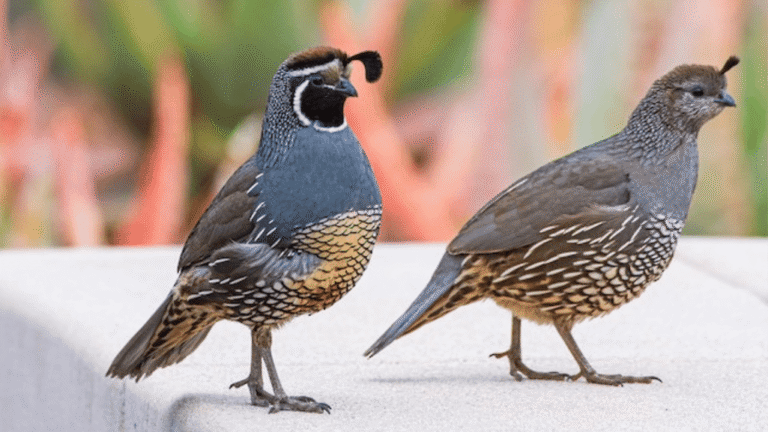Reeves Pheasant is a fascinating bird species with unique characteristics that make it stand out among other pheasants. Known for its stunning appearance and long tail, the Reeves’s Pheasant captivates bird enthusiasts and nature lovers alike.
The male Reeves’s Pheasant boasts a vibrant golden-chestnut body, a white head, and striking black masks that join at the back of the neck. The females, although less eye-catching, still possess a distinctive black pattern on their heads. These pheasants have grey legs, short hooked greenish bills, and brown eyes.
The long tail is one of the defining features of the Reeves’s Pheasant. In fact, it holds the record for having the longest tail among all pheasant species, with males reaching an average length of 210cm (82 inches), while females have tails measuring around 150cm (59 inches). The tail feathers of male birds can grow up to 30cm (12 inches) each year.
Reeves’s Pheasants exhibit significant variation in their plumage, with each individual showcasing its unique colors and patterns. This monotypic species captivates with its diversity and stunning beauty.
Key Takeaways:
- Reeves’s Pheasant is known for its striking appearance, with vibrant golden-chestnut plumage.
- Males have a long tail, the longest among all pheasant species, which can grow up to 30cm (12 inches) each year.
- The plumage of Reeves’s Pheasants varies greatly between individuals, showcasing unique colors and patterns.
Behavior and Breeding of Reeves’s Pheasant
Reeves’s Pheasants exhibit fascinating behavior and breeding patterns that contribute to their unique characteristics.
During the breeding season, males can display aggression towards humans, animals, and other pheasants. This aggression is often driven by their increased territorial instinct and their desire to protect their partners. Males are known to have multiple female partners, making them polygynous in nature.
The nests of Reeves’s Pheasants are carefully constructed shallow bowls, composed of leaves, pine needles, and herbs. Typically, these nests are built on the ground, within the grass or shrubs of the forest undergrowth.
Female Reeves’s Pheasants undertake the responsibility of incubating a clutch of approximately 6 to 9 eggs. These eggs are usually cream or olive-colored in appearance. Females diligently care for the hatched chicks on their own.
The average lifespan of a Reeves’s Pheasant is around 9 years, during which time they exhibit their fascinating breeding behaviors and contribute to maintaining their species’ population.
Key Points:
- During the breeding season, Reeves’s Pheasants can become aggressive and territorial.
- Male Reeves’s Pheasants often have multiple female partners.
- The nests of Reeves’s Pheasants are shallow bowls made of leaves, pine needles, and herbs.
- Females incubate a clutch of 6 to 9 cream or olive-colored eggs.
- Reeves’s Pheasants have an average lifespan of approximately 9 years.
Conservation Status of Reeves’s Pheasant
Reeves’s Pheasants, scientifically known as Syrmaticus reevesii, are currently listed as Vulnerable and considered an endangered species. Their conservation status is a matter of concern due to their declining population and the various threats they face in the wild.
In China, where the majority of the population resides, there are an estimated 2,500 to 10,000 mature individuals. Unfortunately, the population trend is showing a steady decline. Factors contributing to this decline include habitat loss, poaching, and poisoning.
Reeves’s Pheasants have also been introduced to certain parts of Europe, such as the Czech Republic and France. However, even these introduced populations are experiencing a slow decline, further highlighting the precarious state of these birds.
The combination of their limited worldwide distribution and the increasing threats they face makes encountering a Reeves’s Pheasant in the wild a rare and remarkable experience.
Reeves Pheasant
The diet and habitat of the Reeves’s Pheasant play crucial roles in its survival and well-being. Let’s explore the dietary preferences and habitat requirements of this magnificent bird.
Diet of Reeves’s Pheasant
The Reeves’s Pheasant is an omnivore with a diverse diet. Its primary sources of food include seeds and fruits like berries and nuts. However, these pheasants are opportunistic feeders and readily consume a variety of insects, snails, worms, buds, and fresh shoots.
The diet of Reeves’s Pheasants can vary depending on their geographical range. The availability of food influences their foraging behavior. These pheasants primarily forage on the ground, using scratching and digging motions to uncover their sustenance.
Reeves’s Pheasants often feed in small groups, often consisting of closely related individuals. These communal feeding sessions can include up to 10 or more birds. By feeding together, they not only share information about food sources but also enhance their social bonds.
Habitat of Reeves’s Pheasant
The Reeves’s Pheasant is native to the forested regions of China, particularly in areas with evergreen woodlands, grassy meadows, and bushy slopes. They thrive in habitats that provide sufficient cover, food sources, and suitable roosting areas.
Introduced populations of Reeves’s Pheasants in Europe have adapted to lowland forests and can occasionally be spotted in farmland surroundings. However, their numbers are declining, primarily due to habitat loss and degradation.
Reeves’s Pheasants select habitat with an abundant supply of vegetation and dense understory, providing both food and shelter. These birds are well-suited to forested environments, where they can camouflage with their vibrant plumage and find ample resources.
Image: Reeves’s Pheasant
Table: Diet and Habitat Summary
| Diet | Habitat |
|---|---|
|
|
Conclusion
The Reeves’s Pheasant is renowned for its striking appearance, characterized by a golden-chestnut body, white head, and notably long tail. Male birds showcase unique black masks, while females display an attractive black pattern on their heads. During the breeding season, these pheasants exhibit interesting behaviors, and it is the females who shoulder the responsibility of caring for the eggs and chicks.
Regrettably, the Reeves’s Pheasant population faces significant threats, leading to its endangered status. Habitat loss, poaching, and poisoning are the main culprits driving the decline of these exquisite birds. To ensure their survival for future generations, it is imperative that we make concerted efforts to conserve their habitats and address the challenges they encounter.
By protecting the Reeves’s Pheasant and its environment, we can preserve the beauty and uniqueness of this remarkable species. Let us work together to reverse the trends in their population decline, allowing future generations to appreciate the distinctive characteristics and awe-inspiring presence of the Reeves’s Pheasant.
FAQ
What are some interesting facts about Reeves’s Pheasants?
Reeves’s Pheasants have a vibrant golden-chestnut body, white heads, and long tails. Males have black masks, while females have a black pattern on their heads. Their tail can grow up to 30cm (12 inches) each year, and males weigh around 1500g (53 ounces) while females weigh around 950g (34 ounces).
How do Reeves’s Pheasants behave during the breeding season?
During the breeding season, Reeves’s Pheasants can exhibit aggression towards humans, animals, and other pheasants. Males become more territorial and protective of their partners. They are often polygynous, having more than one female partner. Females build shallow nests on the ground and incubate a clutch of 6 to 9 eggs, caring for the chicks on their own.
What is the conservation status of Reeves’s Pheasants?
Reeves’s Pheasants are listed as Vulnerable and considered endangered. Their population in China ranges from 2,500 to 10,000 mature individuals and is on a steady decline due to habitat loss, poaching, and poisoning. Introduced populations in Europe, particularly in the Czech Republic and parts of France, are also declining slowly.
What is the diet and habitat of Reeves’s Pheasants?
Reeves’s Pheasants primarily feed on a mixture of seeds, fruits, insects, snails, worms, buds, and fresh shoots. They forage on the ground in small groups and can be found in evergreen woodlands, areas with grass and bushes, steep slopes in China, and lowland forests and farmland in Europe.

